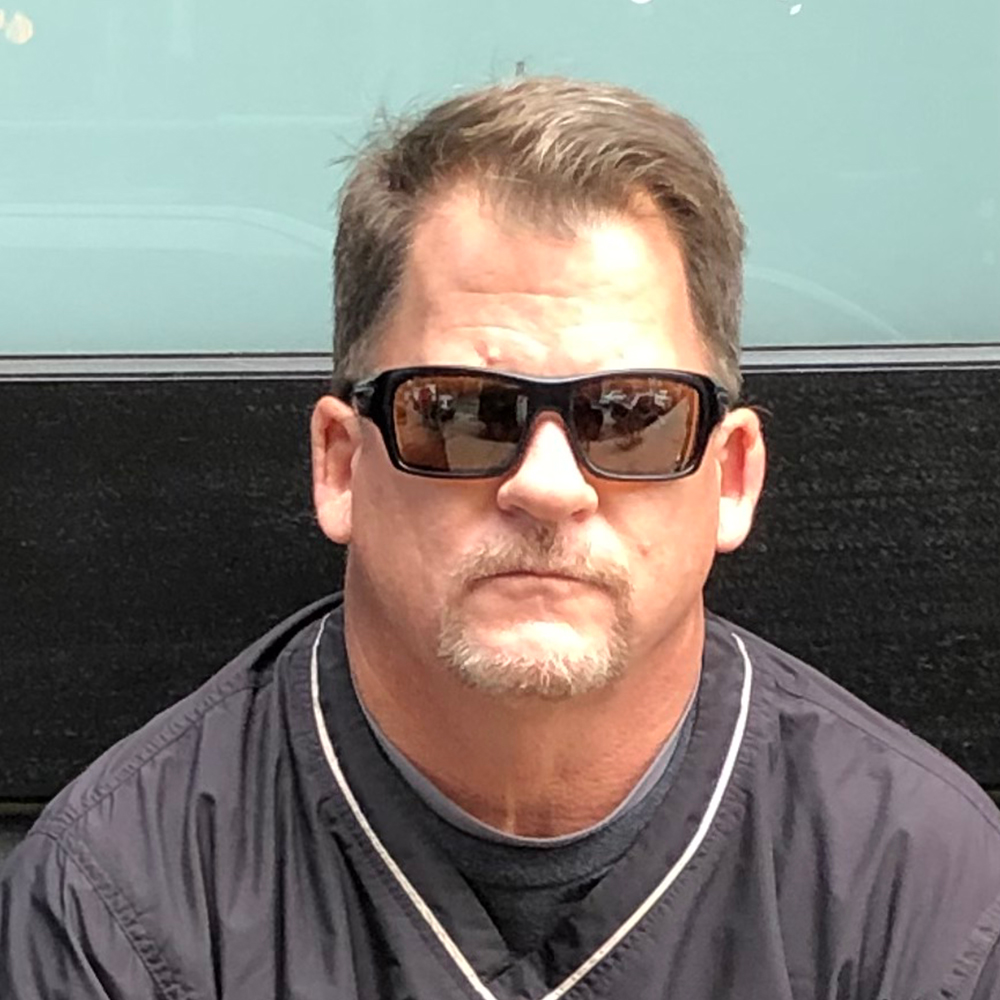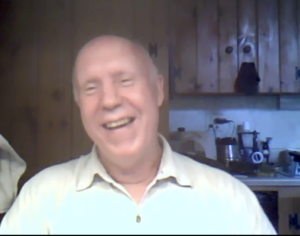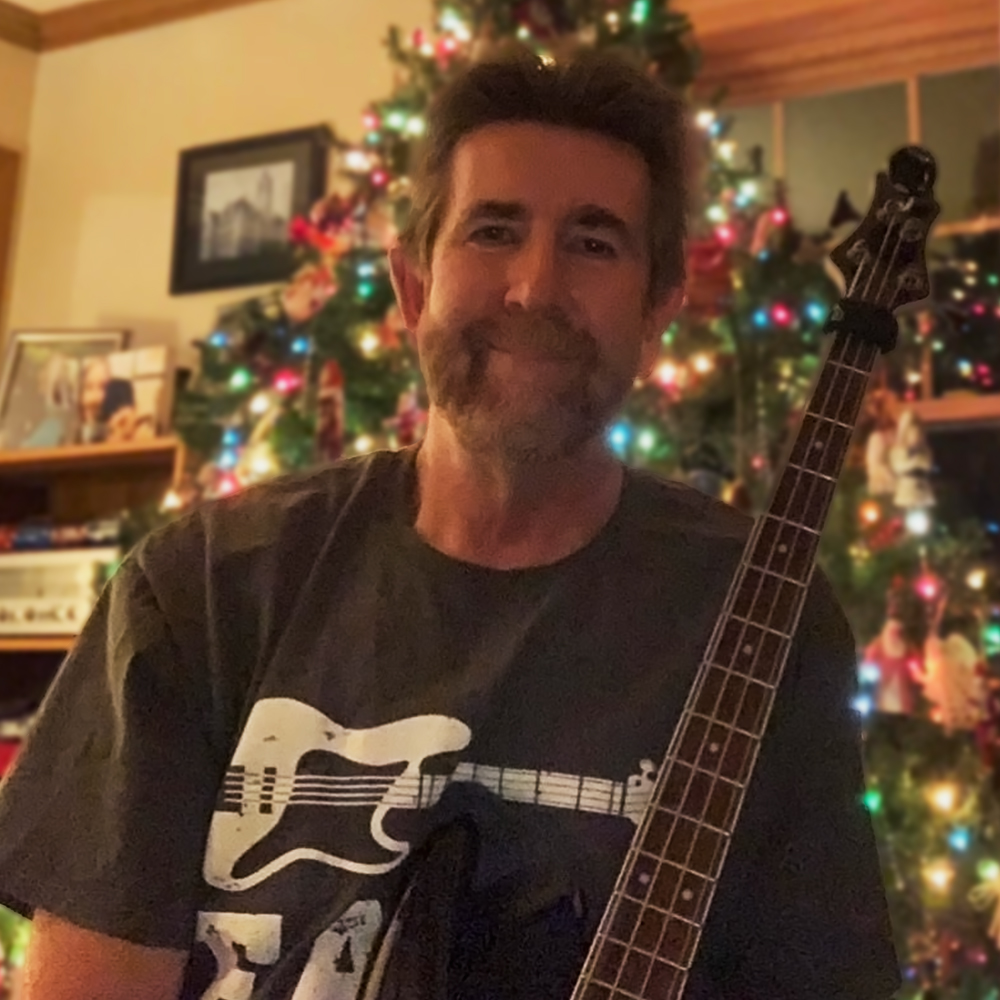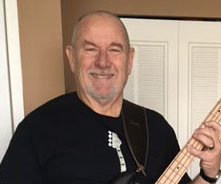“Let’s just jam!”
You hear the drummer say, as he launches into a groove you’ve never heard before. The groove itself sounds great, but you start getting a little bit confused. You think to yourself:
“Just jam? But what am I supposed to do with that? What do I actually play?”
Without warning, the keyboardist just starts playing as well, but this isn’t a song or riff you recognize - it seems like they’re just making it up on the spot.
All of a sudden, the guitarist starts playing as well - somehow knowing what’s going to sound good over the drums and keyboard.
You look around and realize that you’re the only one not playing something.
You’re just standing there, bass in hand without a clue what to do or even how to start.
Your confusion quickly turns to panic. How are you supposed to just create a bass line on the fly, to a song you’ve never even heard? In fact, it’s a song that’s never even been played.
The drummer gives you an encouraging nod as if to say, “Join in - it’ll be fun!” but you’re not having fun anymore…
Sensing your dread, the keyboard player yells to you, “It’s just a jam on A!”
“OK” you think. “I can play something in A”. So you pluck your open A-string.
To your relief, it actually sounds OK. Maybe - just maybe - you might actually be able to keep up. So you play the A again and again...and again...
Then you realize that you don’t really know what to do other than just play that A in long notes on beat one. And the more you hear yourself playing that A, you realize something about your bass line:

There’s nothing worse than playing a dull, boring, monotonous line - especially when everyone else is playing such cool stuff
You feel like you need to do more, but what?
Then it comes to you - you can easily add the 5th of that A! Your fingers find your way to the 5th and you play…
Root...5th...Root...5th...Root...5th…
And it sounds...OK, but you still feel like what you’re playing is dull, repetitive and almost lifeless; especially when you listen to what everyone else is doing.
The drummer is playing these variations in the grooves and these incredible fills that sound amazing. The guitarist is creating these soaring melodies, and the keyboardist is playing rock-solid chords, but then sometimes adding little melodies in response to what’s happening in the guitar.
All these far more experienced musicians are truly creating something wonderful, and all you can manage to do is…
Root...5th...Root...5th...Root...5th…
You remember there’s other notes in the chord though so you could play a 3rd, right? But then you realize - you have no idea if it’s a jam in A major or A minor, or even something else…
You try the major third, but it doesn’t sound right, so you quickly switch to the minor, but that doesn’t sound like it fits either - and even worse, in your quest to play a cool sounding note, you fell out of the groove.
You try to pass off your error as intentional, but you catch a darting glance from the keyboardist. She noticed your mistake and cringes - almost like your playing hurt her physically. The drummer doesn’t even want to look at you. It’s almost like he’s actively avoiding eye contact.
Now that you’ve messed up the notes AND the rhythm, you struggle to claw your way back to the thing that didn’t totally suck:
Root...5th...Root...5th...Root...5th…
Suddenly, you notice the song start to build up. The other musicians start getting louder, playing more intensely, digging in harder, but you can’t bring yourself to stray too far from the safety of the root and 5th.
The guitarist looks at you as if to say, “Come on - give me something to work with!”
There’s no doubt about it - you’re letting the band down.
You know you need to build up this song with them, you know you need to do more, but every time you try to go outside the safety of the root-5th box, it seems to end in disaster; missed notes, ruined grooves and frosty glares from the people you’re playing with.
Instead of helping build the song up, you only manage to play the same old tired bass line, so the song peters out with no real ending; cut short by your inability to keep up, hold your own and pull your weight.
You imagine how much better they would all sound if they just had a ‘real’ bass player to create more interesting bass lines for them; lines that actually contribute to a good jam session.
It’s like you’re stuck at the kiddie table playing with roots and 5ths while the ‘adults’ are having a completely separate conversation - and it shows.
After the song finishes, you’re embarrassed - even ashamed - about how you played. You want nothing more than to put your bass away in its case and head home, defeated.
The thought of giving up bass entirely even crosses your mind…
Like a knife to your heart, the guitarist glances your way and says,
“Maybe we save the jamming for another time. What’s something we can all play?”
This isn’t a hypothetical - this kind of thing happens all the time. Check out this story from a Become A Bassist subscriber named Tony about a jam session he went to:
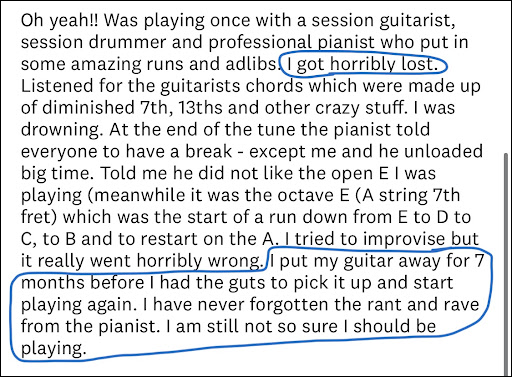
“I got horribly lost...I was drowning…the pianist unloaded on me big time”
Tony’s bass gathered dust in a closet for 7 whole months because of a single bad experience at a jam session.
But why?
What was missing from Tony’s playing that made him feel like he was lost, drowning, and eventually getting told off by that (kind of d*ck-ish) pianist?
What skill would have saved him in this situation and made sure that he could hold his own amongst these professional musicians?
Knowing all his music theory? Having perfect pitch? Blistering technique? Metronomic time and groove?
All of these things would be helpful (and some are a part of the solution), but none of them address the core issue; the single, overarching skill that lets you:
- Go beyond simple root and 5th bass lines
- Meaningfully contribute to whatever song you’re playing; and
- ‘Keep up’ with other, more experienced musicians
So what is it?
The Ability To Create Bass Lines - ‘On The Fly’
And really create - not simply ‘survive’ by plonking away on the root notes on the downbeats.
However, creating bass lines on the fly isn’t something that bassists ‘just know’ how to do.
And even worse, at the mere mention of the idea, a ton of fear can come bubbling up to the surface.
Fear of messing up and killing the vibe and groove of the song.
Fear of getting lost and looking like a fool in front of other, more experienced musicians.
Fear of not being ‘creative enough’ to even make something worthwhile in the first place.
Fear of not doing justice to the music and just playing something dull, lifeless and boring that doesn’t actually contribute at all.
Then of course, there’s the fear of playing wrong notes. (This is a big one…)
So how are you supposed to do it?
Something that a lot of people do when they try to learn to play on the fly is to ask their friends (or the people they’re playing with) how they do it - how they can make music out of thin air.
The only problem with this?
Most of the time, you get two kinds of responses.
Common response #1
You get really vague ‘advice’ that’s not helpful in a practical sense. People say things like:
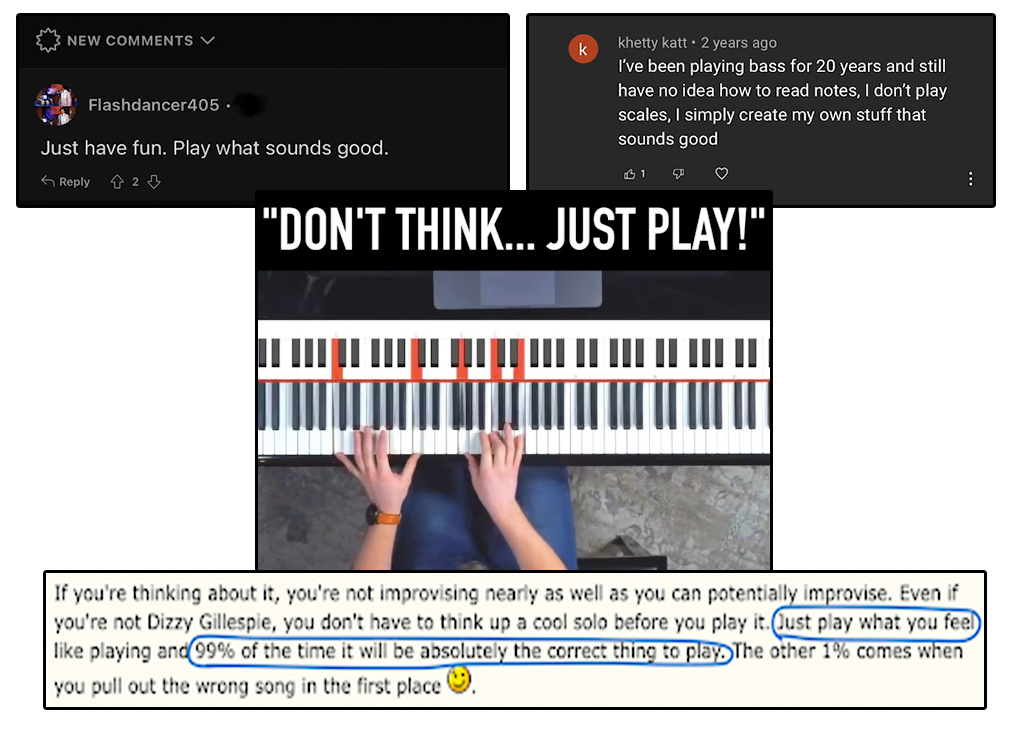
“Play what sounds good? Play what you feel? Don’t think, just play” Not exactly very specific or helpful internet advice about creating on the fly…

“You just have to dare”? Really? That’s ALL you have to do? Ugh…
If you can’t create bass lines on the fly yet, saying things like ‘Improvising isn’t hard’ is a HUGE slap in the face.
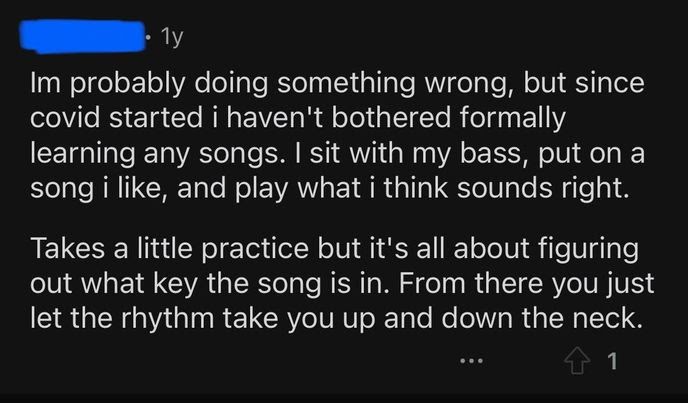
‘Advice’ from a reddit thread where a bassist asked how to make things up on the spot
Will the advice ‘Play what you think sounds right’ or ‘Just let the rhythm take you…’ help if you don’t know where to start?
Probably not…
Usually, the people who give this kind of advice can already jam effortlessly and improvise fluently (or at least they think they can). They likely can’t remember what it’s like to still be at the ‘kiddie table’ when it comes to making music on the fly.
They also likely just taught themselves to make music on the spot, so they don’t actually know how they do what they do, and they’re awful at explaining it to you.
The result? You end up alienated - like there’s a chasm between you and the music you want to create.
Common response #2
You get bombarded with music theory explanations and jargon that leaves your head spinning.
You’re peppered with endless lectures about scales, keys, modes, chords, arpeggios...the list never seems to end.
You try to ask questions, but that inevitably just leads to more explanations that lead to more questions and more explanations, then more questions. It’s a vicious cycle.
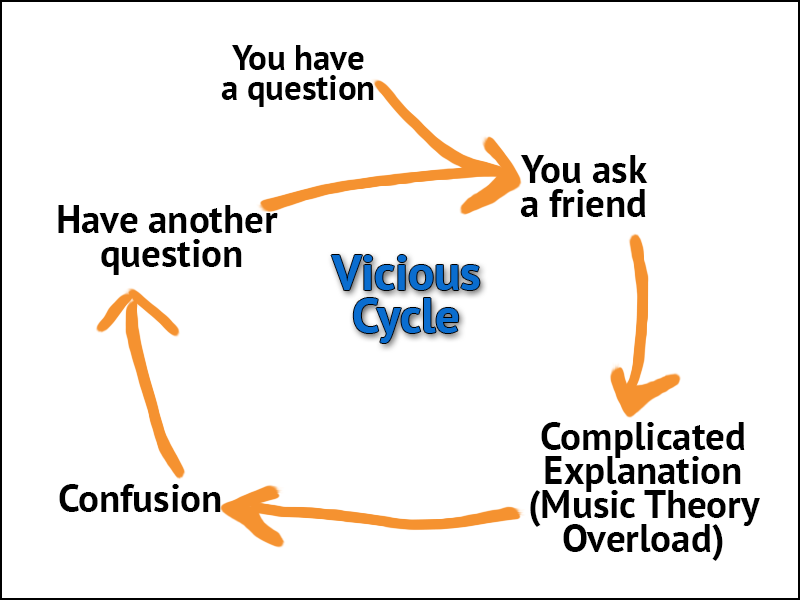
It’s a vicious cycle...
These people who shove you down the theory rabbit hole usually know so much and know it so well that they can’t take things back to basics so you can actually understand what they’re talking about.
The result?
It feels like you’ll never be able to untangle the web of music theory.
When a lot of bassists realize that they can’t make good bass lines on the spot, the first thing they do is turn to music theory.



Theory seems to provide answers, right?
You might dive into learning all you can about how the notes in music are put together, as confusing as that can be.

But what do you notice about all of these things? The scales, modes, arpeggios and all of it…
It’s 100% concerned with the notes.
Now music theory is fantastic. Knowing it and understanding it are crucial when it comes to understanding why you like or dislike the sound of something (and then use that to make bass lines that you actually like)
That’s why lots of bassists will dive headfirst into learning all the music theory they can - to the exclusion of everything else. But when it comes to learning to jam with other people and create bass lines on the fly:
ONLY focusing on music theory is the biggest mistake bassists make
After all, the fear of playing ‘wrong’ notes is so great, so overwhelming, so crippling, that you’ll do just about anything to avoid playing the ‘bad’ notes.
Music theory and figuring out the ‘good’ notes seems to offer a solution to the problem, but it’s woefully incomplete.
Why?
Because you can know all the scales and arpeggios and modes in the world, but if you can’t put them together to create an interesting, solid bass line, then all your theory knowledge goes to waste.
Again - music theory IS definitely important, but just focusing on music theory is like memorizing the dictionary of a foreign language. Sure, you’ll know all the building blocks, but would you be able to have a fluent conversation? Would you understand the local dialect? The slang? The accent?
Of course not.
That’s why only focusing on theory is a recipe for frustration and confusion if you’re trying to create bass lines on the spot.
In fact, I get emails pretty regularly from people who actually know a fair bit of music theory, but still don’t know how to use it to create bass lines.
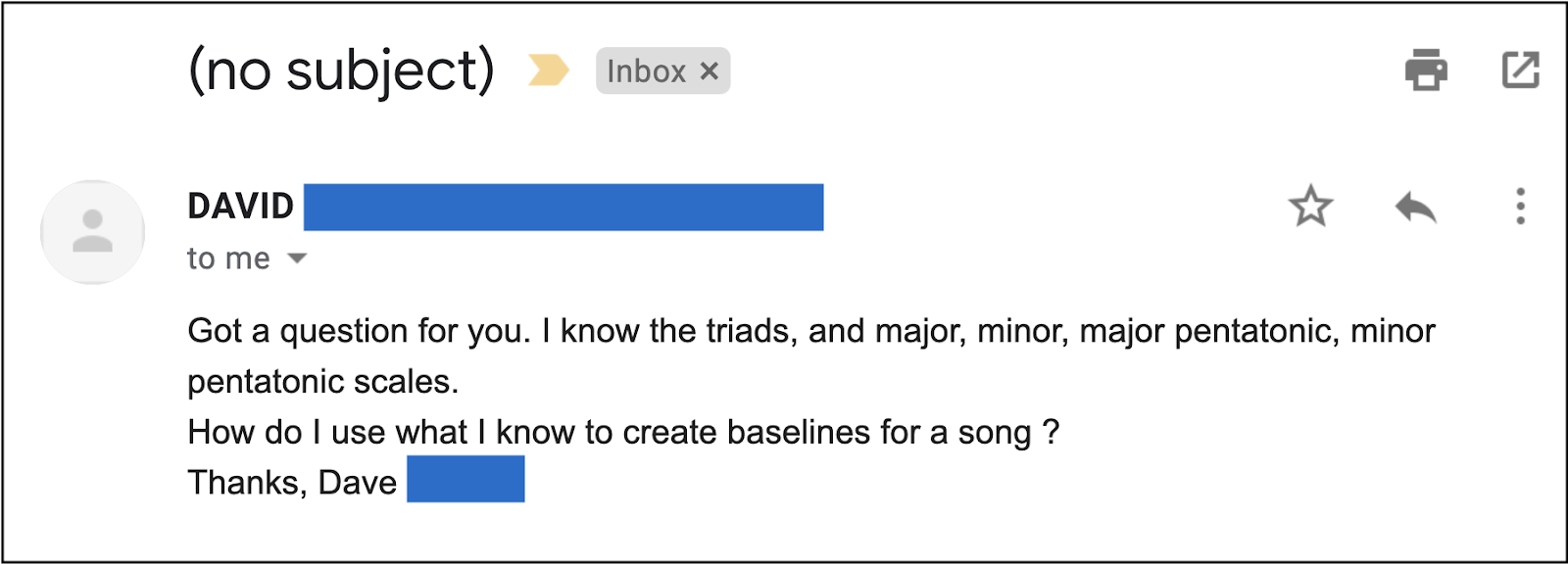
Dave here probably knows more than enough music theory to create great bass lines off the top of his head, but still struggles to actually use what he knows.
So if music theory is only part of the solution, what’s missing?
When bassists struggle to come up with bass lines on the spot, there’s usually at least one crucial ‘ingredient’ missing from their playing.
It’s like baking a cake, but you don’t have any flour. Or eggs. Or milk…
And just like in baking, there’s a recipe that you can follow that guarantees that you can create bass lines on the fly and it’s a recipe I discovered not long ago
I was working with a small group of students who wanted to be able to freely jam with their friends, hold their own among more experienced musicians and break free from the rut of boring, generic root-5th bass lines.
Together, over the course of an 8-week bass line intensive, we figured out exactly what worked and what didn’t when it came to creating bass lines on the fly when jamming with friends, or even just playing along with backing tracks on YouTube.
Together, we uncovered, developed and then refined a ‘recipe’ that just about every great bassist follows when they’re creating bass lines off the top of their head, even if they don’t consciously know it exists.
The recipe itself looks like this:
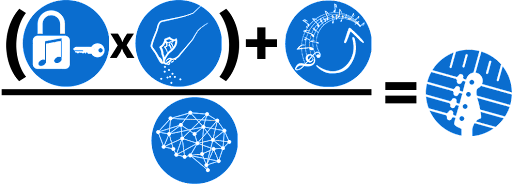
When you know how to use it, this is the secret sauce that lets you:
- Go beyond simply plucking long notes (with the occasional 5th or octave) on beat one
- Meaningfully contribute to whatever song you’re playing and even elicit a “Woo!” of approval from your bandmates
- Break free from the ‘cage’ of music theory (only 2 of the ingredients in the recipe have anything to do with theory, and even then the theory isn’t the main focus)
- Tap into your creativity, even if you think you’re not creative
So what are the ‘ingredients’ in the recipe?

Ingredient #1 - Belief
So many bassists have this idea in their mind that they ‘aren’t creative’ and therefore couldn’t ever come up with a bass line on the fly.
This is doubly true for people who have very logical ‘engineer-type’ brains, for whom the mere idea of creativity seems like a foreign language.
Or they’re deathly afraid of making mistakes when they play, and when they do inevitably mess up from time to time, it completely sabotages their playing and they can’t recover and the song ends in a trainwreck.
So what do these bassists do? A lot of the time, they don’t even try to create something on the fly. If they come up against a song that they haven’t charted out in advance and know super well, they panic and try to convince everyone to play something else, or they just don’t play at all.
The jam session goes on without them…
What they don’t realize though, is that creativity isn’t a ‘gift’ or something you’re either born with or not.
Creativity is a muscle.
And it’s a muscle that you can work, so it gets stronger and stronger. And when you work that muscle and grow it, you don’t freeze or panic when you come up against an unfamiliar song.
Instead, you have an unlimited vault of bass line ideas you can draw from.
And if you make mistakes when you play, but you’ve worked on your creativity and the belief that you can actually create something of your own, those mistakes don’t trip you up.
In fact, you can start using your mistakes as jumping off points for even more bass line ideas.
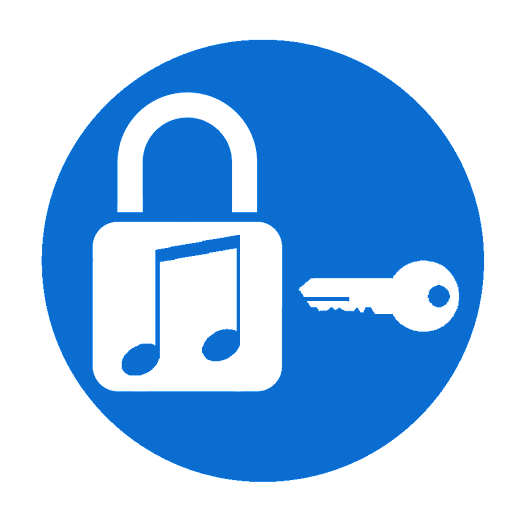
Ingredient #2 - The Rhythmic Key
This is far too common. Bassists get too caught up making sure they’re playing the ‘right’ notes, that they completely neglect the rhythm and end up playing completely out of time or retreat to simply playing long notes on beat 1. They’re not playing to the ‘rhythmic key’ of the song.
What’s the rhythmic key?
Well when people talk about a song being in a ‘key’, they’re almost always talking about the set of notes that works on that song. For example, a song in G major will mostly use the notes from the G major scale. This is the ‘harmonic’ key.
The rhythmic key is different - and it’s not something you’ll find in a book or being taught in music classes in schools or universities.
Where the harmonic key shows you what notes will work in a song, the rhythmic key will show you which rhythms are going to be best to use in a song. It’s simply the rhythmic equivalent of the harmonic key.
Once you decode the rhythmic key of a song, then the most important part of your bass line - the rhythm (not the notes) - is automatically taken care of. You can simply ‘map’ the 3 crucial groove elements and you’ll already have a guide that tells you when to play whatever notes you choose.
This is the thing that most people miss when it comes to creating bass lines on the spot. You’ll hear people say things like “Lock in with the drums” or “Just listen to what the drummer is doing and play to that” which are both technically true, but not very helpful on a practical level.
But if you start thinking in terms of the rhythmic key and decoding it’s 3 elements, you can immediately figure out where to place your notes so you lock in with the drums - automagically.
Drummers will love you for it (as well as all the other musicians you’re playing with).
Even if you play ‘bad’ notes, but you’re still locked into the rhythmic key, you’re fine - even ‘bad’ notes can sound good if you’re playing to the rhythmic key.
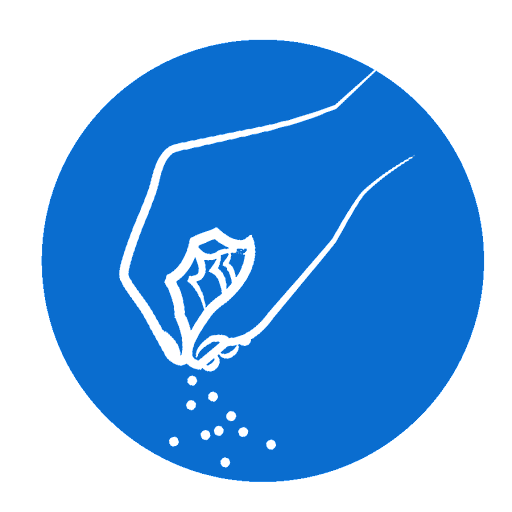
Ingredient #3 - Bass Line Spices
A huge trap that you can fall into when you’re asked to create a bass line on the fly is that you just end up in ‘survival’ mode - just trying to get through the song.
So what do you end up playing? Almost exclusively roots and 5ths. Maybe an octave or a 3rd if you’re feeling super adventurous.
So what’s the antidote to boring bass lines? How do you make sure your bass lines aren’t just plonking away on the root and 5th?
By using bass line spices.
You can think of these as little ‘shots’ of flavor that instantly breathe life and beauty into a bass line and you can find them in just about all great bass players' toolboxes. Bassists like James Jamerson, Duck Dunn, Joe Dart, Chuck Rainey, Pino Palladino, Bootsy Collins all use these ideas to create bass lines.

These players are like the Michelin-Star chefs of the bass world - they know their spices
In fact, they use them so much, it’s almost like these spices, or tiny pieces of language, are ready-made for creating bass lines on the spot.
This language is perfect for adding some of your own unique flavor to your bass lines - to take a dull, boring, lifeless line and make it infinitely more interesting and actually contribute to the song instead of playing the same old mediocre root and 5th bass lines you’ve been playing for ages.
This becomes really exciting because once you know what all the spices are, you can mix and match and create your own unique spice ‘blend’ - the kind of thing that makes your playing unique to you.

Ingredient #4 - Chord Transitions
When your have a deep belief in yourself, can decode the rhythmic key of any song and give spice and flavor to your bass lines, there’s one final step to take your bass line from good to great:
Adding chord transitions.
Now transitions may not sound like the ‘sexiest’ topic when it comes to bass playing, they are the things that will take your bass line from good to great.
They’re the thing that make you sound like a pro; the kind of bassist that other musicians play with and think, “Yeah - they know what they’re doing…”
If your belief is strong, you’re in the rhythmic key, and you’re using your bass line spices, seamlessly moving from chord to chord all over your bass is the maraschino cherry on top of a delicious bass line sundae.
Using these chord transitions, you’ll be able to ‘direct’ the music, create (and release tension) and use your power as a bass player to become the secret conductor of the music.
On top of all that, you can also use transitions to stimulate your creativity even more and get even further out of the root-5th rut that so many bassists often find themselves in.
So what happens when you know this recipe AND know how to use the ingredients inside it?
You Can Finally ‘Hold Your Own’ When Playing With Other, More Experienced Musicians
You head to a jam session, but instead of being nervous and worried about playing ‘boring’ lines or not being able to keep up with the rest of the band, things are different.
You’re excited, you’re itching to play, but most importantly, you’re ready for whatever happens. In fact, you’re looking forward to having some things thrown at you so you can use your on-the-spot bass line skills.
The keyboardist sees you with your bass and asks, “Hey - did you want to get up and play a tune?”
Without hesitation, you reply, “Sure - I’d love to!” as you go to get your bass out of its case.
You head up to the bass amp and plug in, and as you say hello to everyone, the excited energy reaches a peak.
The drummer asks, “What do you all want to play?”
“Let’s just jam on something!” the guitarist says as he launches into playing some chords. He looks around to the rest of the band to tell everyone what he’s playing.
“It’s E minor, then C7, then A7 for 2 bars.” At first, he seems to be talking to the whole band, but then he looks you square in the eye and says, “Are you good with that?”
In that moment, you know he’s talking directly to you. If you can’t keep up with the rest of the band, then it’s game over, the song will end in a train-wreck and you’ll leave the jam with your tail between your legs, never to return...
Just from the chords that he’s playing and the rhythms he’s using though, you’re already imagining a ton of bass lines that would fit perfectly with the guitar groove. All the options are already laid out before you in your mind.
With a quiet confidence, you smile and give him a nod. “Sure. Let’s do it!” you say.
You’ve worked on your belief and your creativity muscle, so you know you’ll be able to create something that sounds great - and if you make mistakes, it’s not a problem. You know exactly how to deal with them and even make them sound good.
As you listen to the guitarist’s groove you’ve already mapped the 3 crucial elements of the rhythmic key, so you already know which rhythms you’re going to be using in advance; ones that you know will sit in the pocket.
Ideas for where to use all the different bass line spices flood your mind. There’s no way you’ll be settling for a dull root-5th bass line right now.
You’re also seeing exactly how you can smoothly transition between all the chords in the guitarist’s progression and make things sound as slick as possible - it’ll sound like you’ve been playing this song for years.
And this is all before you’ve even played a single note.
As the guitarist’s chord progression comes back around to the start, the drummer starts playing a fill, and you know - that’s your time to come in.

This drum fill is your cue
The drummer ends his fill with an almighty
CRASH!
And you’re off and playing, and because you already knew the best rhythms for the groove, your bass line feels huge, it feels solid and draws a great big smile from the drummer. He’s feeling it, so you must be doing something right...
At the start, you keep things simple and just feel out what the other musicians are doing. You’re glued to the rhythmic key, so the groove is solid and you’re creating a fat pocket for the whole band to sit in and it feels great.
You’re also listening and making sure the notes you’re using are working with the keys and guitar parts and everything is gelling together perfectly.
Only a few seconds go by before an extra bass line idea comes to you - one that goes beyond a simple root-note-based line - so you delve into your bass line bag of tricks, find the perfect spice to give your bass line a bit of flavor, and you give it a try...
And it works so well!
You’re still in the pocket, your idea works with the chords - in fact, it gives even more flavor and ‘spice’ to the progression. You’re effortlessly enhancing the music.
The days of long notes on the root and 5th are in the distant past
Instead of playing the same old repetitive bass line for the whole song, you find that if you want to, you can give your line heaps of variations that work rhythmically AND harmonically.
The keyboardist plays a lick that you recognize as being a really common piece of musical language - a piece of language you happen to know - so you sprinkle some bass line ‘spice’ into your bass line that perfectly complements her lick.
The keyboardist notices you doing it and smiles to herself. You’re having a real-life musical conversation now. You’re exchanging ideas, supporting the song, all while your bass line grows and develops - almost on it's own.
When the guitarist starts to take a solo, you feel the intensity of the band rise, so you rise to meet it. You make your bass line a little busier, you dig in a little more, you throw in some ‘spices’ that are a bit more active, and your playing lifts the energy higher and higher.
The whole band is going on this journey together - it’s like your playing is breathing with the rest of the band.
After a while, the song reaches peak intensity - the volume is high, the guitarist is wailing, the drummer is laying into his kit, the keyboard player is deep in the music and you’re right there alongside them, jamming with them.
You’re coming up with super creative bass lines on the fly, effortlessly transitioning between chords, moving all over the neck of your bass. Ideas are coming to you, and you’re getting them out through your bass and making them real.
This is what it’s all about and you can’t help but get swept up in the music.
As the guitarist reaches the end of his solo, the intensity naturally winds down and the song comes to an organic end, the guitarist stops playing, looks around and aims a great big beaming smile right at you.
It’s a smile of acknowledgement and appreciation. He knows you made him sound REALLY good.
The band is nothing but smiles and good vibes. The drummer looks at you and says, “I love what you did at the start there!”
“Yeah - that was great!” the guitarist adds.
The keyboardist jokes, “I heard you stealing my licks - you make them sound better than I do!” and everyone has a good laugh.
On the inside, you beam with pride, but you hardly get a chance to think about it because the guitarist eagerly says, “Let’s play another one!”
Jam after jam after jam, you reach into your bag of tricks and pull out the perfect bass lines for each song. They’re simple when they need to be, and you get more active and more creative when the song calls for it.
You can’t help but notice:
You have total freedom on your bass now
No feeling trapped, playing the same bland, generic root and 5th bass lines for the entire song while everyone around you creates beautiful music - you’re right there, creating it alongside everyone else.
No feeling like you can’t keep up or that your bass lines are letting down the other members of the band - you’ve become a crucial member of the group that everyone wants to jam with.
No icy glares from other musicians when you mess up - all you see are smiling faces of everyone having a great time thanks to the bass lines you’re making on the fly.
No more getting bogged down and confused by the music theory - you know exactly how to make great bass lines on the fly and actually contribute to the song and the jam session (and you’re not even consciously thinking about theory anymore).
No feeling like you lack creativity - you hear a chord progression or drum groove and the possibilities of what you could play jump out at you. You have an idea and you execute it.
If you can’t create bass lines on the spot right now, being able to show up at a jam or rehearsal and ‘just start playing’ can seem like a fantasy, but it’s possible - even inevitable - when you learn the right things.
How You Can Start Effortlessly Creating Bass Lines On The Spot
The idea of those ‘ingredients’ in that bass line recipe - ‘belief’, decrypting the rhythmic key of a song, adding ‘spices’ and making smooth transitions - that was just a theory I had for years. It was just how I personally thought about creating bass lines on the fly, but I wasn’t sure if it would work for other people.
So I decided to test the ideas with a small group of dedicated students.
Twice a week, we got together on Zoom and I taught them everything I could think of when it came to creating bass lines off the top of their heads.
They learned how to:
- Make sense of what a drummer is doing so they were always in the pocket
- Use the very few bass line ‘spices’ in their own unique ways to create virtually unlimited bass line variations
- Raise their ‘Bass I.Q.’ by learning how the music theory worked with what they were playing
- Effortlessly transition from one chord to the next (just like a professional bassist) using some essential root-connectors
- Practice the skill of creating bass lines on the fly
Then they went away into the real world and applied what they had learned.
The results were astounding
Students, like Joshua C. actually had other people notice that he was contributing more - and loving it:

“I really liked what you did...you should do more of that”
It’s one thing to notice improvements in your own playing, but for other people to notice as well is next level.
And since then, Joshua has built up the courage to join a brand new band; something that was unthinkable to him before learning how to create bass lines on the fly.
Another student, Mike, couldn’t manage more than 60 seconds of jamming with backing tracks before falling apart. And now:
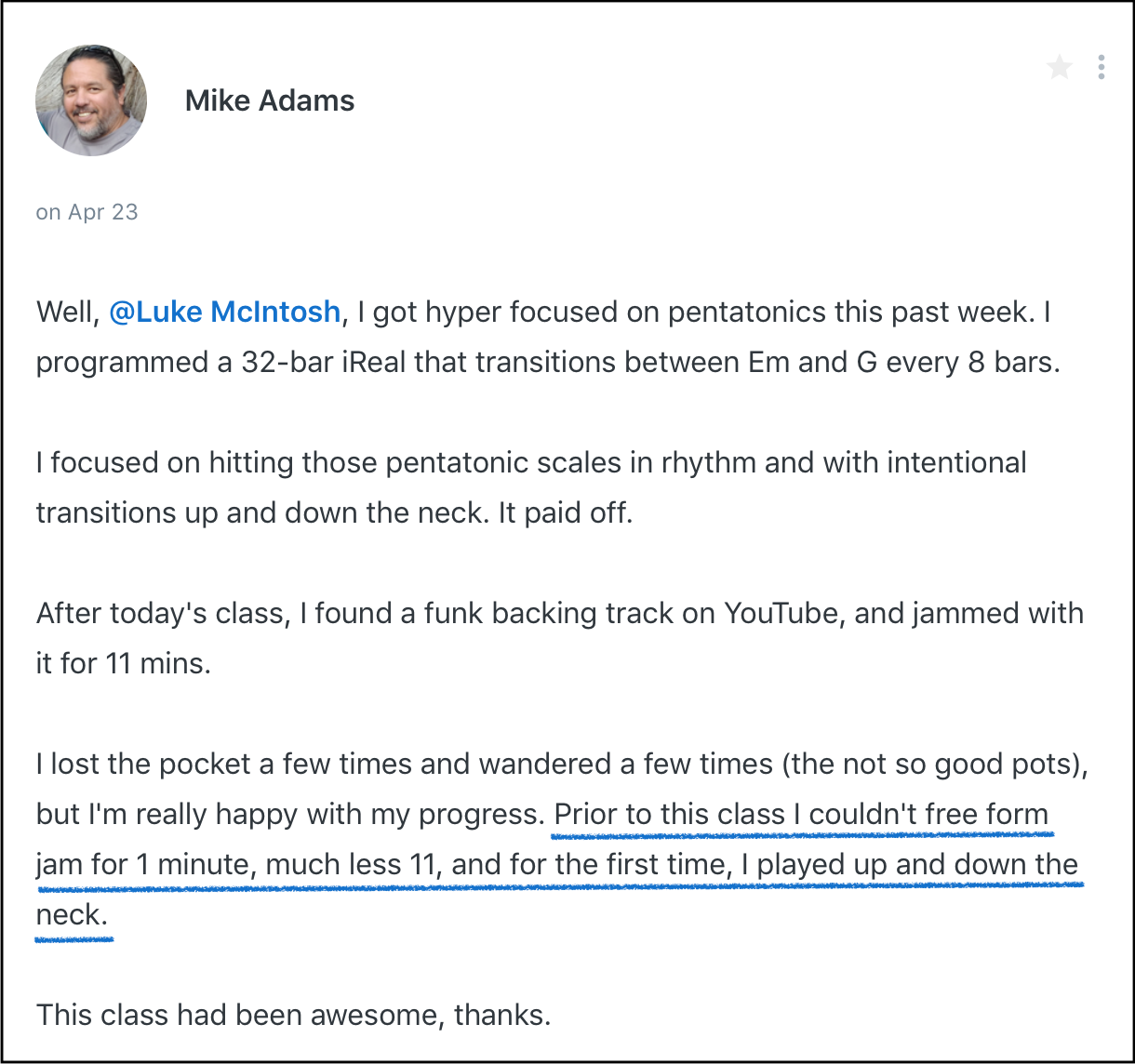
From struggling to jam for 1 minute to jamming for 11 minutes
And since the class has finished, Mike can actually jam for even longer, and with more confidence than ever before.
Patty H, who used to take weeks to create a single bass line (that she didn’t even like), can now create beautiful bass lines instantly:

“In the beginning, my bass teacher would say, “OK, we have this chord progression”. I’d take weeks trying to come up with a bass line and I keep changing it up, and saying “Oh – that’s awful!”…but now I can usually come up with things right away.”
Patty H.
Some of these students had been playing for years and hadn’t learned the skill of creating bass lines on the fly, but now, they finally feel like they’re pulling their weight; like they’re playing for real.
Their friends and other, more experienced musicians don’t just ‘put up with them’ anymore - they can’t wait to make music together. They’re contributing and supporting the bands they play with in a concrete way and they’re creating real music together.
They didn’t do all this through endless theory-bashing (although we did cover all the theory). These students learned by actually going through the process of creating - a process they learned.
And they did it in a matter of weeks.
It didn’t take a decade-long doctoral music degree.
It didn’t take a year of rigorous academic theory classes.
It didn’t take months of endless learning of other people’s bass lines.
They learned how to do it in a matter of weeks, and today, I want to share with you how they did it.
I’m super excited to share with you my new online course:
Introducing

Use my unique step-by-step system to go BEYOND roots, 3rds and 5ths, create your own bass lines on the fly, and ‘hold your own’ with more experienced musicians in just 6 weeks!
Even if you:
- Feel overwhelmed by music theory
- Can’t seem to get past root-5th or 1-3-5 bass lines
- Get stuck playing the same old lines over and over
- Believe you’re ‘not creative’
- Can play other people’s bass lines, but can’t create your own
- Know some theory, but aren’t sure how to use it
Bass Lines On The Fly is a 6-week online video course with a singular goal: to prepare you to play create amazing bass lines at the drop of a hat that you can use at jam sessions, rehearsals, gigs, worship services - or even if you just want to put on a random YouTube backing track and play along.
But the bass lines you’ll learn to create won’t be your standard, pedestrian bass lines. They’ll be bass lines that catch people’s attention and make them smile and say, “Woah - what was that? Do more of that!”
And it’s all step-by-step so you always know exactly what to do next to take your bass lines to the next level.

“I also have memberships to other web-based bass courses…I haven’t found anything else that would show me how to create a bass line on the fly. I found one teacher that could teach me about theory and technique…Another bass teacher has a song-based approach…but there’s a big donut hole in the middle with how do I get from ‘here’ to actually playing something. I thought Luke’s course was very pragmatic in that I came away with, ‘Hey I can use this immediately’.”
Chris P.
Here’s How The Course Works
When you join Bass Lines On The Fly, you’ll get access to a private members’ area, where every week, for 6 weeks, I’ll send you new material designed to help you create bass lines on the fly.
Week by week, you’ll build your skills from the ground up using ultra-practical drills and by the end of the course, you’ll be creating bass lines to songs you’ve never heard before and doing it all on the fly.
Here’s a breakdown of what we’ll be covering:
Module 1 - The Bass Lines On The Fly Mindset
Before we even start thinking about creating bass lines, it’s vital to realize that when you’re making bass lines on the fly, you’re essentially improvising. For some people, improvising can be a bit of a scary word, but it doesn’t need to be. All it means is you’re training the ideas you have in your mind to come through your fingers, and out of your bass.
The Bass Lines On The Fly mindset is essentially an improviser’s mindset and that’s what you’ll learn in module 1.
- The two critical concepts to internalize that will make creating bass lines on the fly SO much easier (and one of them you can start implementing instantly)
- The ‘theory-free’ way of intuitively connecting your mind to your fingers - do this and getting your bass line ideas from your mind to your bass becomes a breeze
- The reason I can prove you are creative and how you can tap into your innate creativity
- How to ‘squeeze’ an incredible amount of music out of limited notes - master this skill and you’ll always have tons of options when it comes to creating your bass lines
- How to make mistakes your best friend so even if you do make mistakes when you’re playing, you can actually make them sound good

“[The Module 1 creativity drill] was a very interesting exercise that seemed very mundane at first, but just giving it a different order, different spacing etc. – that was a bit of an epiphany because I felt like I’m in a rut playing triads, but I haven’t played them backwards, forwards, upside down and sideways until now and that was really cool.”
Pablo M.

“After the 1st couple of weeks the creative juices were flowing more than they had in a while because I had a reason to practice. It rejuvenated my enthusiasm for playing.”
Alex D.
Module 2 - Decoding The Rhythmic Key
Rhythm is king when it comes to creating bass lines on the fly. If you select great rhythms and you’re solid when you play them, you’re golden. But if the rhythms you pick are weak or just don’t fit with the rhythmic key, then your bass line will be a flop before you even get started.
That’s why in module 2, you’ll learn:
- Exactly what a rhythmic key is and how to ‘decode’ it - This isn’t something you’ll find in textbooks or being taught in university music classes, but it makes a huge difference to your bass lines
- How to listen to a drum groove, a guitar riff or keys progression and know exactly how to find the pocket in an instant
- More than a dozen common rhythmic keys that you’ll find in the wild - learn these and coming up with a great bass line is almost plug-and-play
- How to make sure you never fall into the rut of just playing long notes on beat one
- 11 ways you can add a ton of variety to any bass line without changing the notes at all
- How (and where) you can modify the rhythmic key to make your bass lines your own

“The concept of a rhythmic key is probably the thing that was most, “OH!” It’s sort of something that you’re kind of aware is there, but then, when you really think about it, that’s HUGE. That to me, was really, really important and that’s something I think about all the time now.”
Joshua C.

“Specifically the rhythmic keys was a good concept. I would still go into a gig thinking about syncing with the drummer, but absent a strong drummer I now realise I have a portfolio of like 12 bass patterns I can use to establish a groove. … I feel like I have a full toolbox now and that I could reach in and pull something out to get started.”
Chris P.
Module 3 - Adding Your Bass Line ‘Spices’
Once you’ve got a solid, functional bass line and you’re playing solidly within the rhythmic key, then all you need to do is breathe some life into your bass lines and make them your own. That’s exactly what module 3 is all about.
You’ll learn:
- A piece of James Jamerson language you can use that instantly elevates a bass line from good to great (plus tons of other examples from bassists Duck Dunn, Chuck Rainey and Nate Watts)
- How you can use different ‘spices’ to craft bass lines - You can even use these to make existing bass lines more ‘your own’
- Exactly what it takes to make a great bass line on the fly and how to practice that skill so you can always do it
- How to take a solid, functional bass line and turn it into something beautiful that contributes to the song and makes other people want to play with you
- How you can mix and match all of the different bass line spices and use your own proprietary spice blend when you’re jamming with others

“Before this course, I was playing just the notes from the root to the octave – I’d never thought of expanding beyond that…[Now] if I just see a backing track on YT and have the chord progressions, I’d play it and just use the spices and you wouldn’t really think about it because, somehow, it just works.”
Jimmy K.

“As we got into the Spices I was starting to zoom in on those bass lines. That’s what connected with me. Naming the spices helped separate them and give them personality. I felt so happy because this is what I’m here for! And now I feel like I’m getting the tools to do this as it makes sense in my head.”
Herm S.
Module 4 - Bass Line Spices For ‘Static’ Songs/Jams
If a guitarist just started playing a one-chord vamp at a jam session, or if a drummer just started playing a groove, do you know what to do? Would you be able to take a 10-minute song on a single chord and keep things interesting the whole time? It can be tricky, but it’s definitely a learnable skill and that’s what module 5 will teach you.
You’ll learn:
- The Bootsy Collins ‘spice’ that you can use over a James Brown-style vamp that’s guaranteed to work
- Other ‘spices’ that bassists like Joe Dart, Larry Graham, Flea, and Paul Jackson use to make their bass lines in funk jams sound amazing
- Exactly where to use all the different language and devices so you always know exactly what your options are in just about every situation
- The ‘pungent’ funk spices that can stand all on their own and the milder ones which aren’t as useful for creating bass lines
“…Before the class, my bass lines were stale. It was all the same things. I knew where the roots and 5ths are – one note before, one note after… with this, it just opens things up a little bit more. More variety. It makes you feel great.“
John N.

“It’s great to have this in your pocket. To think, I can get into this, I can spice it up – it’s a good thing. I couldn’t do this before BLOTF – I’d just stay with root, root, go to the next root… When this happened, I realised the song sounded too plain…so I moved it along that way, and then they kept playing, so I kept adding more. I just knew what to do. It was nice. It makes me feel like a better player.”
Jeff S.
Module 5 - Solid, Fluid and Memorable Chord Transitions
Once you’re in the rhythmic key, you’ve created your own ‘spice blend’ to make your bass lines unique to you, the next step is getting from one chord to another in a seamless way; a way that lays out the harmony in a really supportive way for everyone else in the band.
You’ll learn:
- The 4 most important chords to know when it comes to transitions and how to fluidly move between all of them
- The 2 main methods of moving between chords that you can plug in to just about any progression
- The ‘slingshot’ method that ensures you always land on the right notes at the right time (and prevent premature articulation)
- How solidly transitioning between chords makes life easy for everyone in the band and makes you the kind of bassist that people crave playing with

“I realised how far with just a few conventions, or basic chordal knowledge, you can come up with a lot of ideas from just that – with just a few notes. I’m getting a lot better at squeezing a lot out of a little. It makes things less stressful… It makes things a lot more approachable.”
Alex D.
Module 6 - Master The ‘Pressure-Free’ Jam Session
The real test of how well you can play bass lines on the fly, is actually doing it at a real jam session. The problem with this is that the stakes are pretty high - you don’t want to mess up in front of other people, right? That’s why in module 6, your task is to create bass lines on the spot at a pressure-free simulated jam session.
You’ll learn:
- The most important thing to remember if you do make a mistake, plus how to minimize the impact of any mistake you make in a real-life situation
- How to play with the intensity of a song - You have almost ALL the power when it comes to building the song up or stripping it back and you’ll learn exactly how to wield this power
- What to do if you get lost in a song and the ways you can find the path back ‘home’
- How to take a bass line you made on the fly and make it better and better until it’s the best version of the original line - perfect if you’re writing songs or just want to be creative
Then you can take the skills you learn doing this and apply it to real-world jam sessions.

“In fact, I played [the jam session drill from Bass Lines On The Fly] for my son and about halfway through, he said, “You’ve hit a few wrong notes, but you really do make it work”. And then he said, ‘So how long have you been working on this?” And I said, “Well that’s the first take.” And his eyes – he was like “What?!?” He said, “That was your first take?!?” …He listened to it a 2nd time and about halfway through he said, “You know – in this song, you sound like you’re almost a professional bass player. You sound like you’re a part of the recording” and I was pretty happy with that…When he gives me a compliment, I take it pretty well.”
Michael A.
Raise Your ‘Bass I.Q.’
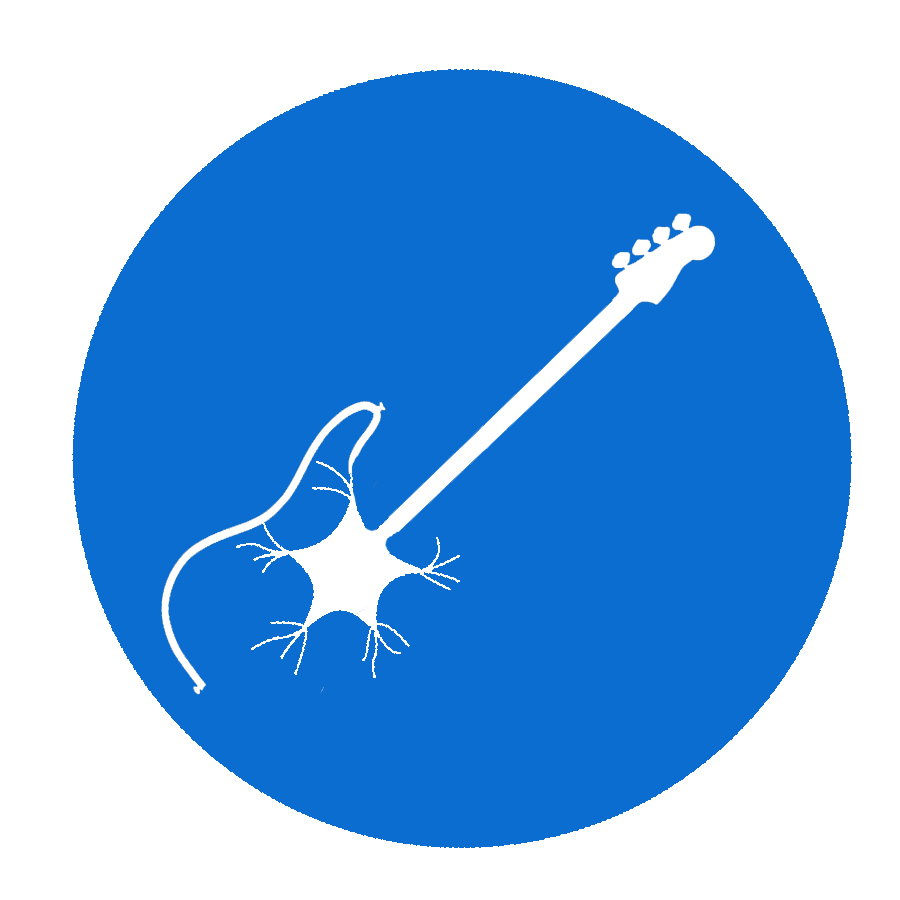
One of the core principles of Bass Lines On The Fly comes from Pablo Picasso who said this:
Learn the ‘rules’ like a pro - so you can break them like an artist.
That’s why when you join the course, you’ll raise your ‘Bass I.Q.’ but learning the inner workings of music theory alongside the practical application of it.
Like I said, ONLY focusing on music theory is a mistake, but completely neglecting theory is just as bad.
In the Bass I.Q. portion of the course, you’ll be guided, step-by-step through music theory in a logical, linear way. Not bouncing around from YouTube video to YouTube video collecting ‘tip soup’.
You’ll learn exactly what you need to know - when you need to know it and in terms you can easily understand.
But not only will you be able to learn and understand the theory, you’ll see how that theory is used in real-world music and how you can use that knowledge to create your own bass lines on the fly - ones that you can be proud of.
Then, when you’ve mastered the ‘rules’, then you can strategically break them, and still sound great doing it, but more importantly, you’ll be totally in control of what you’re doing.

“I never really understood the theory. I was always struggling to understand what I should be playing, other than just the root notes…The Bass IQ helped me understand where it all fits in with music in general, not just filling in and slotting into the songs…I now know WHY I’m doing something, rather than just following the guitar playing.”
Gervase B.
BONUS: The Rhythmic Key Masterclass
When I first released Bass Lines On The Fly, the students got so much out of Module 2: Decoding The Rhythmic Key, and after they devoured all the material, some of them had very specific questions about how it worked in the ‘real world’.
I could have just made some videos answering the questions, but I wanted to go one step further.
I wanted to show you how the rhythmic key worked when you’re playing with other real musicians on the fly.
So I got together with some very close musician friends and we had a jam.
But of course, we didn’t just stop there. As we went through it all, we broke down exactly how we are thinking about what we're doing so you can learn to do this kind of thing for yourself.
With one exception, everything you see in the masterclass is made up on the fly - exactly how it would be at a 'real-life' kind of jam session scenario.
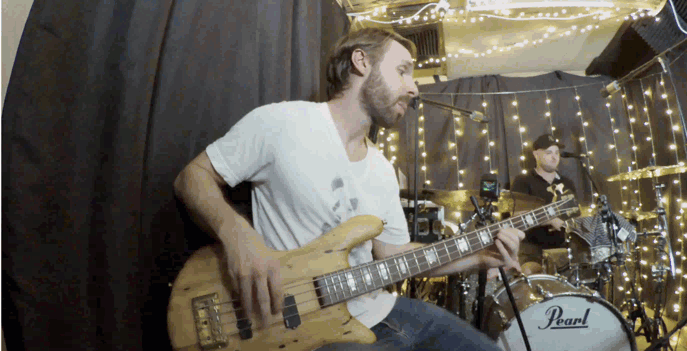
In this hour-long masterclass, you'll learn the answers to some crucial rhythmic questions like:
- Should you always play the same rhythm as the kick drum? (2:59)
- How do you know if the rhythms you create and the grooves you play are actually 'good'? (4:02)
- At what point in a song can you start playing fills/getting a bit fancier? (8:20)
- Who 'leads' when it comes to the rhythmic key? (9:02)
- Can you mix and match different rhythmic keys in a song? And if so, how? (14:40)
- How do you get in the groove when there aren't any drums in the band? (21:55)
- What happens when what you're hearing in your mind doesn't match with the other musicians? (27:13)
- When the drummer changes up what they're doing, should you also change? Or keep doing the same thing? (33:09)
- What parts of the drum kit should you listen to in order to 'lock in'? (34:10)
- What kinds of things do other musicians hate? Aka. What should I avoid doing when it comes to rhythm? (42:34)
- When you need to 'just play something', how can you get ideas? (44:58)
- What do other musicians look for in a good bass player? (49:25)
- How can you make all the other musicians comfortable with your own playing? (53:25)

“[My biggest win] is really understanding the drum beat/groove…This should be so obvious, but no previous bass teacher really showed me how to do this. They all said that synchronizing with the kick drum was really important, then I was taught a bunch of disconnected notes. So all the different drum beats and showing how to link the various devices you have taught us has been unbelievably helpful.”
Alastair K.

“One of the things I couldn’t do before was just put on a blues track and just jam for hours…but, very quickly, [the course] gives you the basic ability to be able to play along with this stuff. I couldn’t even come close to that before.”
Rob G.
BONUS: Effortless Fills On The Fly
Being able to create great bass lines on the fly is enough to make you a rock-solid bassist, but if you really want to go the extra mile and add more flavor to what you’re doing, the thing to do is add in some bass fills. Playing great fills means you can put even more of your own unique flavor into the song and make sure you’re contributing to whatever you’re playing.
You’ll learn:
- The 4 different ‘types’ of fills, how they affect the music and where to use each one
- The single most important moment in your fill (and why it has nothing to do with the notes you play)
- How Bootsy Collins makes sure his bass fills carry as much impact as humanly possible
- How Pino Palladino makes his fills as smooth as butter - and how you can do the same thing
- How to make sure your fills never sound like you’re a scale-playing robot
Plus you’ll get access to a library of ready-made fills that you can add to your arsenal and pull them out whenever you need to.

“The analysis of real-world fills combined with science drills have given me confidence to start adding more interest to what I play. On a recent gig, I surprised even myself when I ripped out a second-position pentatonic fill–sounded great and so rewarding!”
Jamie S.
Bonus For Serious Students: 6 Weeks Of Live Bass Line Masterclasses
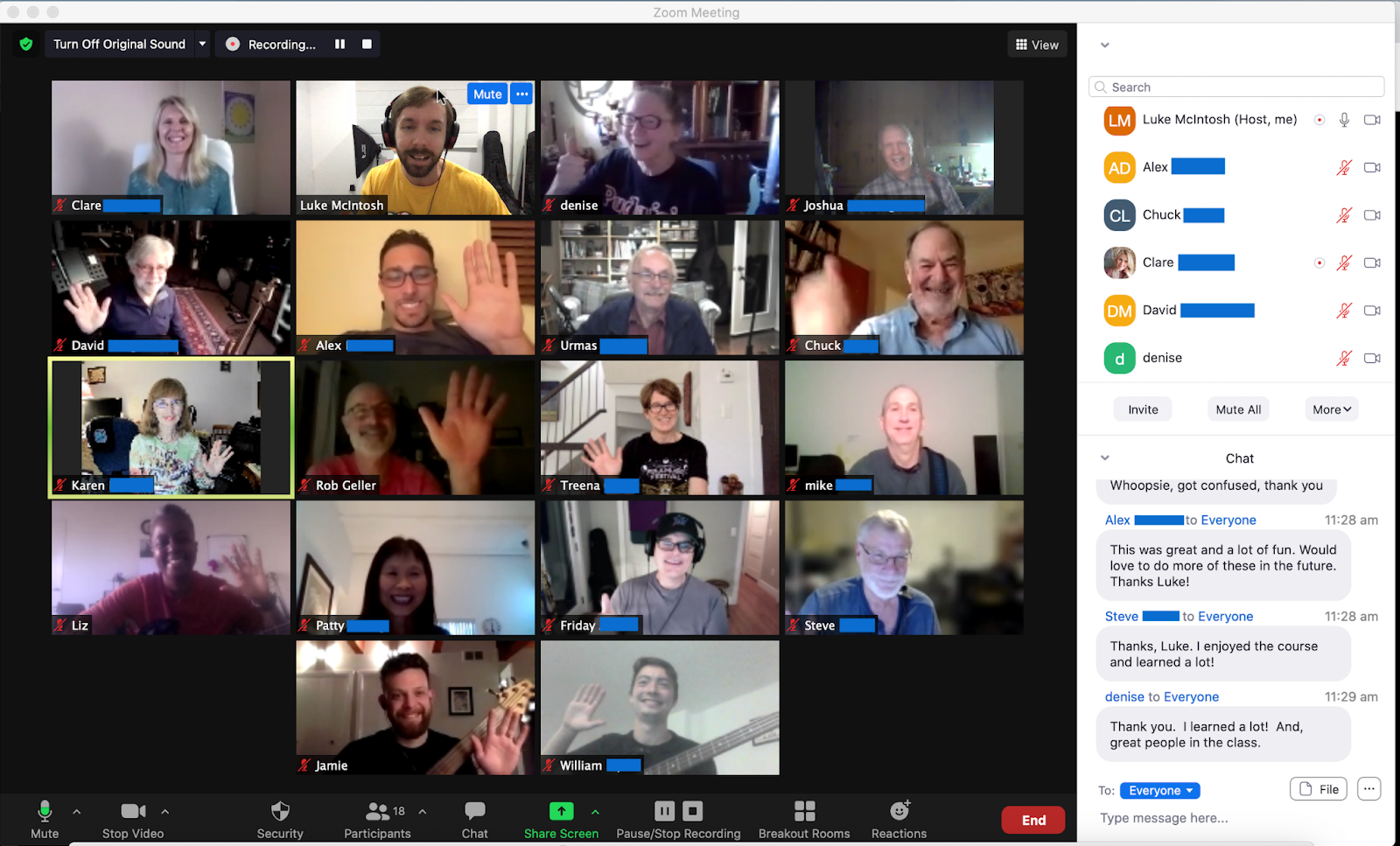
The original class who went through the Bass Lines On The Fly Material
Bass Lines On The Fly is a fully self-paced online video course. Every week for the six weeks of the course, you’ll be sent a new module that will show you the crucial pieces of the puzzle when it comes to making bass lines on the fly.
But instead of just leaving you in the cold to do it all for yourself, Bass Lines On The Fly includes 6 weekly masterclasses where you, me and all the other students in the course will jump on a live Zoom call.
During these hour-long masterclasses, you can ask questions, we’ll do drills together and live playing teardowns, plus we can go deeper into the material from the course.
If you’re struggling to decode the rhythmic key of a song in week 2, bring that song to the masterclass and we can go through it together.
If you’re confused about something theory-related, bring your question to the calls and we can help raise your Bass I.Q.
If you’re not sure how to use the James Jamerson ‘spice’ from module 3, we can go through a ton of different examples on the live call.
In the past, the students who have attended the live masterclasses always learn faster, get stronger results and just get more out of the material.
The dates for these masterclasses will be:
Tuesday November 1st 7PM EDT
Tuesday November 8th 7PM EST
Tuesday November 15th 7PM EST
(Skip a week for U.S. Thanksgiving)
Tuesday November 29th 7PM EST
Tuesday December 6th 7PM EST
Tuesday December 13th 7PM EST
If you can’t make the masterclasses live though, don’t worry. I’ll be recording all of them for you and sending out the links afterwards.
If you have burning questions that you want to ask, but can’t make the calls live, just send me an email in advance and I can answer it for you right there on the call and you can go through it whenever it suits you.
Frequently Asked Questions
“Am I ready for this course?”
Bass Lines On The Fly is not for the rank beginner who has just started playing. In my experience, beginners should first focus on developing technique (so they don’t hurt themselves while they’re playing) and groove (so they can make their playing feel good and play with others).
That’s why the two crucial criteria for joining Bass Lines On The Fly are:
1. You can play without causing pain in your body (hands, wrists, shoulders, back etc.)
Playing with pain is a pretty good indication that something is wrong and needs to be fixed, possibly by correcting your technique. If that sounds like you, then Bass Lines On The Fly isn’t a good fit at the moment and you’d probably benefit more from my course Level Up Your Technique.
2. You can confidently play some bass lines
Even if you didn’t create them yourself - and you can play them in time and they feel reasonably good. That means playing some songs the whole way through and staying in the groove pretty comfortably.
Rhythm is a core element of Bass Lines On The Fly, so you need to be relatively competent with it.
These songs don’t need to be perfect (a few slip ups is totally fine), but if you can make a bass line groove, then you’re ready to learn to create them for yourself on the spot. If not, then I’d recommend checking out my other course Level Up Your Groove.
“How much time will this take?”
To get the most out of the course, I recommend you spend at least 30 minutes a day, 5 days per week going through the videos and exercises.
Of course, if you do more, you’ll likely see results faster, but 30 minutes a day is a good starting point to get the most out of the material.
The course is entirely self-paced though, and when you join Bass Lines On The Fly, you have lifetime access to the course, plus any future updates for it. This means that if you need some extra time with one of the modules or life gets in the way, that’s totally fine. Just come back to the course whenever you’re ready.
“What if I’m not creative? Will this work for me?”
I believe that every single person on the planet has the capacity for creativity. If you think back to when you were a child, you more than likely created through drawing or singing or telling stories - and you play bass now, so the capacity for creativity is definitely inside you. It’s just a matter of uncovering it.
You can still tap into your innate creativity and make bass lines at a jam session that sound great, even if your mind is naturally very ‘logical’ or ‘linear’, like an engineer or analyst.
In fact, a lot of the original Bass Lines On The Fly Students were engineers, or had very methodical engineering-type minds and they were able to get great results from the course. Students like Michael, whose day job is software engineering:

“I’m gonna tell you right now. This is the best bass course I’ve taken. I got way more out of this than out of virtually anything else I did…You clearly have sat down and thought about how to present material in a very organized fashion.”
Michael A.
Some students never ‘heard’ music in their head before they played, but can now create beautiful bass lines whenever they need to, like Patty:

“[My teachers and I] had been jamming for a few months and most of the time at the beginning, I was just doing root, then 3 and 5 and I wasn’t hearing anything in my head. It was very frustrating… But when I joined, a few weeks later, my teacher says, “Hmm…you play a lot different now” and that’s when I told him I’m on the online lessons…I feel more confident, more comfortable and I don’t feel nervous. I feel like I have more to offer to the band in a way. I can hold my own.”
Patty H.
Even if you genuinely believe that you’re not creative, you can still use the material to create bass lines on the fly. Mapping the rhythmic key of a groove and adding some of your own bass line spice is a surefire way to create great bass lines in a ‘paint-by-numbers’ way.
Then, when you’re feeling more comfortable and start to realize that you can be creative and that you can create solid, functional bass lines, then you can start to take more liberties with your lines and put your own personal stamp on everything you do.
“Do I need to be able to read music to take the course?”
In short - no. For every example and exercise from the course, I include regular music notation AND tabs. If you can’t read music, but prefer tab, I’ve got you covered. And of course, if you prefer the notation, you can simply disregard the tabs.
In fact, if you don’t know how to read tabs or notation, I demonstrate everything in great detail, so even if you just play by seeing and hearing, you can still squeeze all the ‘juice’ out of the material in Bass Lines On The Fly.
“I don’t know ANY music theory at all. Will this work for me?”
You don’t need any prior music theory knowledge to get a ton out of the course. That’s exactly what the Bass I.Q. component of Bass Lines On The Fly is for.
You’ll learn the most important theory concepts (that actually apply to creating bass lines) so even if you’ve never learned the first thing about music theory, you can still learn to make bass lines on the spot.
We cover the absolute basics, so even if you don’t know things like where notes are on your fretboard or what the notes even are, you’ll learn all of that in the Bass I.Q. lessons in the course.

“I felt there was a gap – I’d never really understood the instrument. I always thought that maybe I should have taken lessons back in the day when I first moved over to bass guitar…To me [BLOTF] was doing those lessons that I felt I should have done probably 30 years ago. It was basically filling in that gap.”
Gervase B.
“Should I wait until I know more music theory before I join?”
In short - no.
The best way of actually learning theory is through using it and creating bass lines from scratch and then delving into theory to explain why it works.
In fact, the idea of needing to know ‘more’ theory to get started is flawed and goes against how music fundamentally works.
Theory didn’t come before the music itself. It wasn’t like the first ‘Music Theorist’ created all the rules and musicians created music based on those rules.
People created music, and then others came along and gave everything names and created music theory to explain and understand the music.
It’s the same when you’re trying to learn to create music and bass lines. Creating the music first, and then using theory to explain what you create is a better way of creating AND understanding what you make.
So the idea that you need ‘more’ music theory knowledge before creating doesn’t hold up to reality. Plus, with the Bass I.Q. component of Bass Lines On The Fly, you’ll be guided through the whole process of using theory and applying it to your playing.

“I will say that the way Luke introduced the modes and modal music was extremely helpful to me. I’d learned about the modes half a dozen times, and never come away with anything useful or constructive I could use…The way Luke taught it, it was so simple and so useful.”
Dave M.
“I already know a ton of music theory. Will this help?”
There’s a big difference between ‘knowing’ music theory and actually being able to apply it. If you’re the kind of bassist who’s already dived deep into theory - and knows a lot - but still can’t seem to come up with bass lines when you’re thrown into a jam, then this course will absolutely help.
You’ll learn how to actually use the music theory you know to consistently create great bass lines on the fly. Not 2 measures that ‘kind of’ sound good before it falls apart, but bass lines that sound great the whole time you’re playing and make you and everyone you’re playing with smile. This is exactly what happened to previous students:

“Before I could actually play bass with any level of competency, I was pretty heavy in my understanding of music theory…It was the application of that knowledge that was so far beyond me…A lot of what I got out of this course – it put me in a position where I’m able to start to utilize that knowledge that I built up about theory.”
Michael A.
Since you already know the theory side of things, you’ll actually have a bit of a leg-up. You’ll be able to dive deep into the areas where you may be lacking when it comes to creating bass lines: decrypting the rhythmic key of songs and absorbing the core bass line language.
You can simply skip over the Bass I.Q. elements in the course and focus your attention where it’s most needed.
“What if I don’t want to learn the theory part?”
If you don’t want to learn the music theory aspect of creating bass lines on the fly, then you shouldn’t join the course.
A core concept of Bass Lines On The Fly is that you should learn the rules like a pro, so you can break them like an artist. That means learning the ‘rules’ so well that you know when and how to completely throw them out the window.
If you willfully ignore the theory side of things for whatever reason:

That’s why at every step of Bass Lines On The Fly, you’ll raise your ‘Bass I.Q.’ by learning the theory behind what you’re playing.
I mentioned earlier that only focusing on music theory is a huge mistake, but it’s also a mistake to willfully ignore music theory and if you want to spontaneously create great bass lines at jam sessions, rehearsals or even on gigs, then learning a little bit of theory will go a long way.
However, if you’re the kind of person who refuses to consider learning music theory concepts, this is not the course for you and you shouldn’t join.
“How is Bass Lines On The Fly different from Level Up Your Ear?”
The difference is in creation vs. re-creation.
Bass Lines On The Fly is specifically about how to create bass lines on the spot based on what is going on in the song.
My other course, Level Up Your Ear, is about ear training - figuring out what others are playing and then figuring out how to re-create that.
Level Up Your Ear will help you figure out what the other musicians are doing, but Bass Lines On The Fly will show you how to instantly create a bass line that works perfectly with everything going on in the jam, rehearsal or gig.
60 Day Money Back Guarantee
The goal of Bass Lines On The Fly is to give you everything you need to create great bass lines at the drop of a hat whether you’re:
- At a jam session
- A rehearsal
- A full-blown gig
- A worship service
- Playing along to backing tracks on YouTube
- Or just noodling around by yourself at home
After the six weeks of the course, I’m certain you’ll be infinitely more confident in your ability to create music on the spot, with more experienced musicians and be able to pull your weight and actually contribute to the songs you’re playing.

60 Day Money Back Guarantee
I want to give you the best possible chance of learning how to do all these things and that’s why Bass Lines On The Fly comes with a rock solid 60-day money back guarantee.
Here’s how it works:
Try out the course risk-free for 60 days. Watch the videos, play along with the practice tracks, download the PDFs, do the exercises, come to all the bass line masterclasses, try out all the different methods and bass line spices.
60 days covers the entire length of the course and then some, so there’s more than enough time to really sink your teeth into the material and start creating bass lines out of thin air.
If you don’t like the course for any reason or if you’re not satisfied with the results the course gives you, just email me within 60 days of joining and I’ll refund every cent. I believe in the course I’ve created and I want to make sure there’s absolutely no risk for you to join.
Join Bass Lines On The Fly
Bass Lines On The Fly Standard
- Get the full Bass Lines On The Fly course - 6 weeks of HD lessons designed to show you how to start creating great bass lines out of thin air
- [BONUS] 6 weeks of live Bass Line Masterclasses where you, me and all the BLOTF students can get together on Zoom and accelerate your learning
- [BONUS] Rhythmic Key/Drum Groove Masterclass - Learn how to lock into the rhythmic key when playing with any drummer
- [BONUS] Effortless Fills - How to create bass fills that sound great and contribute to the song instead of sabotaging it
- [BONUS] Module 1 Voice Masterclass - Learn how to use your most powerful tool when it comes to creating bass lines on the fly
- An hour-long 1-on-1 lesson with me to guide you through the process of creating bass lines on the fly and answer any questions you have
Join Bass Lines On The Fly
STANDARD
GET INSTANT ACCESS - 6 payments of $39
Bass Lines On The Fly Master
- Get the full Bass Lines On The Fly course - 6 weeks of HD lessons designed to show you how to start creating great bass lines out of thin air
- [BONUS] 6 weeks of live Bass Line Masterclasses where you, me and all the BLOTF students can get together on Zoom and accelerate your learning
- [BONUS] Rhythmic Key/Drum Groove Masterclass - Learn how to lock into the rhythmic key when playing with any drummer
- [BONUS] Effortless Fills - How to create bass fills that sound great and contribute to the song instead of sabotaging it
- [BONUS] Module 1 Voice Masterclass - Learn how to use your most powerful tool when it comes to creating bass lines on the fly
- An hour-long 1-on-1 lesson with me to guide you through the process of creating bass lines on the fly and answer any questions you have
Join Bass Lines On The Fly MASTER
GET INSTANT ACCESS - 6 payments of $99
Bass Lines On The Fly Standard
- Get the full Bass Lines On The Fly course - 6 weeks of HD lessons designed to show you how to start creating great bass lines out of thin air
- [BONUS] Rhythmic Key/Drum Groove Masterclass - Learn how to lock into the rhythmic key when playing with any drummer
- [BONUS] How To Thrive At A Blues Jam Session - Your foolproof guide to holding your own playing one of the most common jamming scenarios - the 12-bar blues
- [BONUS] How to Master the Jazz Jam Session - Your crash course in playing walking lines at a jazz jam session
- [BONUS] Effortless Fills - How to create bass fills that sound great and contribute to the song instead of sabotaging it
6 weeks of live Bass Line Masterclasses where you, me and all the BLOTF students can get together on Zoom and accelerate your learningAn hour-long 1-on-1 lesson with me to guide you through the process of creating bass lines on the fly and answer any questions you have
Join Bass Lines On The Fly
STANDARD
GET INSTANT ACCESS - 6 payments of $59
Bass Lines On The Fly Pro
- Get the full Bass Lines On The Fly course - 6 weeks of HD lessons designed to show you how to start creating great bass lines out of thin air
- [BONUS] Rhythmic Key/Drum Groove Masterclass - Learn how to lock into the rhythmic key when playing with any drummer
- [BONUS] How To Thrive At A Blues Jam Session - Your foolproof guide to holding your own playing one of the most common jamming scenarios - the 12-bar blues
- [BONUS] How to Master the Jazz Jam Session - Your crash course in playing walking lines at a jazz jam session
- [BONUS] Effortless Fills - How to create bass fills that sound great and contribute to the song instead of sabotaging it
- 6 weeks of live Bass Line Masterclasses where you, me and all the BLOTF students can get together on Zoom and accelerate your learning
An hour-long 1-on-1 lesson with me to guide you through the process of creating bass lines on the fly and answer any questions you have
Join Bass Lines On The Fly
PRO
GET INSTANT ACCESS - 6 payments of $79
Bass Lines On The Fly Master
- Get the full Bass Lines On The Fly course - 6 weeks of HD lessons designed to show you how to start creating great bass lines out of thin air
- [BONUS] Rhythmic Key/Drum Groove Masterclass - Learn how to lock into the rhythmic key when playing with any drummer
- [BONUS] How To Thrive At A Blues Jam Session - Your foolproof guide to holding your own playing one of the most common jamming scenarios - the 12-bar blues
- [BONUS] How to Master the Jazz Jam Session - Your crash course in playing walking lines at a jazz jam session
- [BONUS] Effortless Fills - How to create bass fills that sound great and contribute to the song instead of sabotaging it
- 6 weeks of live Bass Line Masterclasses where you, me and all the BLOTF students can get together on Zoom and accelerate your learning
- An hour-long 1-on-1 lesson with me to guide you through the process of creating bass lines on the fly and answer any questions you have
Join Bass Lines On The Fly
MASTER
GET INSTANT ACCESS - 6 payments of $99
All prices in USD
Enrolments Close In:
Some Bassists Stay Trapped - Others Earn Freedom
If someone just wants to jam or play an unfamiliar song, do you hit the panic button?
Do you freeze up? Does your mind go blank? Do you sometimes struggle to play anything at all?
And even if you manage to play something, do you either plod along playing long notes on the roots or stumble all over their fretboard and just end up with a bunch of noise?
And if all the other musicians around you are creating great music, it’s not uncommon to wonder:
“Why do they put up with me?”
But you don’t have to be the kind of trapped bass player who other musicians merely ‘put up with’; the kind of bass player that’s tolerated because bassists are rare.
You can escape the cage of the familiar and earn your freedom to create great bass lines out of thin air. I know it’s possible because I’ve taught people how to do it.
You can be the kind of bassist that gets commended, congratulated and admired by the people you play with and get unsolicited compliments on your bass lines, like Dave, Jeff and Ruth:

“Our band was playing [Del Shannon’s Runaway] and I was just playing a very simple bass line – roots and 5ths – and I was always disappointed because I didn’t think it was very interesting. Then, as this course went on, I decided to see if I could play arpeggios along the major and minor chords and I started doing that and the guys in the band started saying “Woah! Where did that come from!?” It was so transformative in that song. The band members noticed I was playing something much more interesting. In some cases I’ve turned uninteresting bass lines into something more artistic, something more melodic.”
Dave M.

““I tell you what, I’ve grown – and I can see it. Even my wife can hear it. I was playing and I had the door open, and I’d never heard her say anything about my playing before, but she said, ‘You’re good enough to play in that band. You sound good!’”
Jeff S.

“[My husband] started noticing the difference [in my playing] early in the course. I started with a country song and I just sort of put a different beat in it and was like ‘Wow!’. It just sounded so nice, it was lovely in the chorus…He said, “Your playing has gone to a new level since starting this course”, which inspired me to practice more.”
Ruth K.
You can finally hold your own when playing with other, more experienced musicians, like Patty did when she blew away her teacher:

“2 weeks ago, during a jam session, we were playing several chord progressions and that day, my teacher said I was on fire! So I did the [bass line ‘spices’] that you taught and I did them in different places and with a faster rhythm and doing it seamlessly. For 3 chord progressions, I did it and then my teacher says, “WOW! Is this our Patty today?” They said that it was the funnest jam session we ever had for the past year – so they were very pleased.”
Patty H.
Instead of feeling like you’re drowning in confusing music theory, you can have crystal clear clarity on exactly what’s going to work - in advance - like Mike and Jeff have now:

“For me, there were 50 different questions I’ve had in my mind forever, and this course answered them. I feel like there’s so many things that I now understand that I didn’t before. It makes me feel a lot better about myself as a bass player!…I feel a little bit more in the league of the players who know all that stuff.”
Mike E.

“Thanks to the [Bass IQ], I’ve started listening to songs and realize, ‘Oh, that’s what that is’. I can figure out more than I used to…[Having more theory] makes you feel better, like you’re making progress, rather than questioning, ‘Am I doing all this wasting my time?’….”
Jeff S.
You can have total freedom on your fretboard like Denise, Urmas, and Ruth (who took her color-coded ‘dots’ off her bass after years of using them as a crutch):

“[Now] I can play in the upper range of the bass, which I never was doing before. I’ve even had comments like “Wow, what are you doing?!” (in my other class)… that’s pretty much because Luke has had me working in that part of the bass.”
Denise C.

“The pentatonic scales shapes up and down the neck are very, very handy. I was aware of them before… but now I think I’ve got a far more solid understanding of where they sit…now I feel like the whole fretboard is my playground.”
Urmas S.

“I’ve had dots on my fretboard for a few years – I was too frightened to take them off, especially when I’m at a gig… I’ve just been playing boop, boop, boop, boop for about 5 years – but I had to know which boop to go to…When Luke said I want you to learn the fretboard and we had to do the exercises up and down… the fear disappeared. I thought I shouldn’t be cheating having the dots there… and I just took them off and it was the best thing ever!”.
Ruth K.
And perhaps most importantly, you can have unshakeable confidence in your abilities to make something up on the spot that you know is going to sound great and meaningfully contribute to whatever you’re playing:

“What I find myself doing now is seeking out bass-free backing tracks on YouTube. Now I’m deliberately listening to those and am like, “Hey, I can do something with these” whereas before I couldn’t…I didn’t really know where to start. Now it’s like, “Oh I at least have a starting point” It gives me the confidence to get stuck into that. I feel like I have the tools now to create my own music, whereas before I was just mimicking what another artist had already created. It’s great!”
Chris P.

““Before BLOTF, I would just keep on the root notes – that’s it… I never really paid attention to the rhythm, and when you hear a chord change I’d just press it and let it ring until the next chord comes in. But, when you have the rhythmic key, you can first follow the drum beats and then, when you’re more familiar with that song you can start being creative. Fun!”
Jimmy K.
Bass Lines On The Fly has worked incredibly well for these students and it can help you too, but it’s up to you to make the decision.
Enrollments are closing this Friday at 11:59PM EST, so if you’re ready to learn to create bass lines out of thin air, make sure you enroll before the deadline.
I’d be honored to have you as a student in the course. I’ll see you inside.
Cheers,

Join Bass Lines On The Fly
Bass Lines On The Fly Standard
- Get the full Bass Lines On The Fly course - 6 weeks of HD lessons designed to show you how to start creating great bass lines out of thin air
- [BONUS] 6 weeks of live Bass Line Masterclasses where you, me and all the BLOTF students can get together on Zoom and accelerate your learning
- [BONUS] Rhythmic Key/Drum Groove Masterclass - Learn how to lock into the rhythmic key when playing with any drummer
- [BONUS] Effortless Fills - How to create bass fills that sound great and contribute to the song instead of sabotaging it
- [BONUS] Module 1 Voice Masterclass - Learn how to use your most powerful tool when it comes to creating bass lines on the fly
- An hour-long 1-on-1 lesson with me to guide you through the process of creating bass lines on the fly and answer any questions you have
Join Bass Lines On The Fly
STANDARD
GET INSTANT ACCESS - 6 payments of $39
Bass Lines On The Fly Master
- Get the full Bass Lines On The Fly course - 6 weeks of HD lessons designed to show you how to start creating great bass lines out of thin air
- [BONUS] 6 weeks of live Bass Line Masterclasses where you, me and all the BLOTF students can get together on Zoom and accelerate your learning
- [BONUS] Rhythmic Key/Drum Groove Masterclass - Learn how to lock into the rhythmic key when playing with any drummer
- [BONUS] Effortless Fills - How to create bass fills that sound great and contribute to the song instead of sabotaging it
- [BONUS] Module 1 Voice Masterclass - Learn how to use your most powerful tool when it comes to creating bass lines on the fly
- An hour-long 1-on-1 lesson with me to guide you through the process of creating bass lines on the fly and answer any questions you have
Join Bass Lines On The Fly MASTER
GET INSTANT ACCESS - 6 payments of $99
Bass Lines On The Fly Standard
- Get the full Bass Lines On The Fly course - 6 weeks of HD lessons designed to show you how to start creating great bass lines out of thin air
- [BONUS] Rhythmic Key/Drum Groove Masterclass - Learn how to lock into the rhythmic key when playing with any drummer
- [BONUS] How To Thrive At A Blues Jam Session - Your foolproof guide to holding your own playing one of the most common jamming scenarios - the 12-bar blues
- [BONUS] How to Master the Jazz Jam Session - Your crash course in playing walking lines at a jazz jam session
- [BONUS] Effortless Fills - How to create bass fills that sound great and contribute to the song instead of sabotaging it
6 weeks of live Bass Line Masterclasses where you, me and all the BLOTF students can get together on Zoom and accelerate your learningAn hour-long 1-on-1 lesson with me to guide you through the process of creating bass lines on the fly and answer any questions you have
Join Bass Lines On The Fly
STANDARD
GET INSTANT ACCESS - 6 payments of $59
Bass Lines On The Fly Pro
- Get the full Bass Lines On The Fly course - 6 weeks of HD lessons designed to show you how to start creating great bass lines out of thin air
- [BONUS] Rhythmic Key/Drum Groove Masterclass - Learn how to lock into the rhythmic key when playing with any drummer
- [BONUS] How To Thrive At A Blues Jam Session - Your foolproof guide to holding your own playing one of the most common jamming scenarios - the 12-bar blues
- [BONUS] How to Master the Jazz Jam Session - Your crash course in playing walking lines at a jazz jam session
- [BONUS] Effortless Fills - How to create bass fills that sound great and contribute to the song instead of sabotaging it
- 6 weeks of live Bass Line Masterclasses where you, me and all the BLOTF students can get together on Zoom and accelerate your learning
An hour-long 1-on-1 lesson with me to guide you through the process of creating bass lines on the fly and answer any questions you have
Join Bass Lines On The Fly
PRO
GET INSTANT ACCESS - 6 payments of $79
Bass Lines On The Fly Master
- Get the full Bass Lines On The Fly course - 6 weeks of HD lessons designed to show you how to start creating great bass lines out of thin air
- [BONUS] Rhythmic Key/Drum Groove Masterclass - Learn how to lock into the rhythmic key when playing with any drummer
- [BONUS] How To Thrive At A Blues Jam Session - Your foolproof guide to holding your own playing one of the most common jamming scenarios - the 12-bar blues
- [BONUS] How to Master the Jazz Jam Session - Your crash course in playing walking lines at a jazz jam session
- [BONUS] Effortless Fills - How to create bass fills that sound great and contribute to the song instead of sabotaging it
- 6 weeks of live Bass Line Masterclasses where you, me and all the BLOTF students can get together on Zoom and accelerate your learning
- An hour-long 1-on-1 lesson with me to guide you through the process of creating bass lines on the fly and answer any questions you have
Join Bass Lines On The Fly
MASTER
GET INSTANT ACCESS - 6 payments of $99
All prices in USD
Enrolments Close In:
P.S. Still on the fence? Have a look at what some of my previous students said after going through the Bass Lines On The Fly Material:

“I’m gonna tell you right now. This is the best bass course I’ve taken. I got way more out of this than out of virtually anything else I did…You clearly have sat down and thought about how to present material in a very organized fashion…”
Michael A.

“I never thought that bass lines could be created so easily. I would have thought, unless you’re a really experienced player who’s played for many years in a lot of bands and you know the theory inside out, that is the only time you can create bass lines. But right after this course, which was about 1 1/2 months, I could do it.”
Jimmy K.
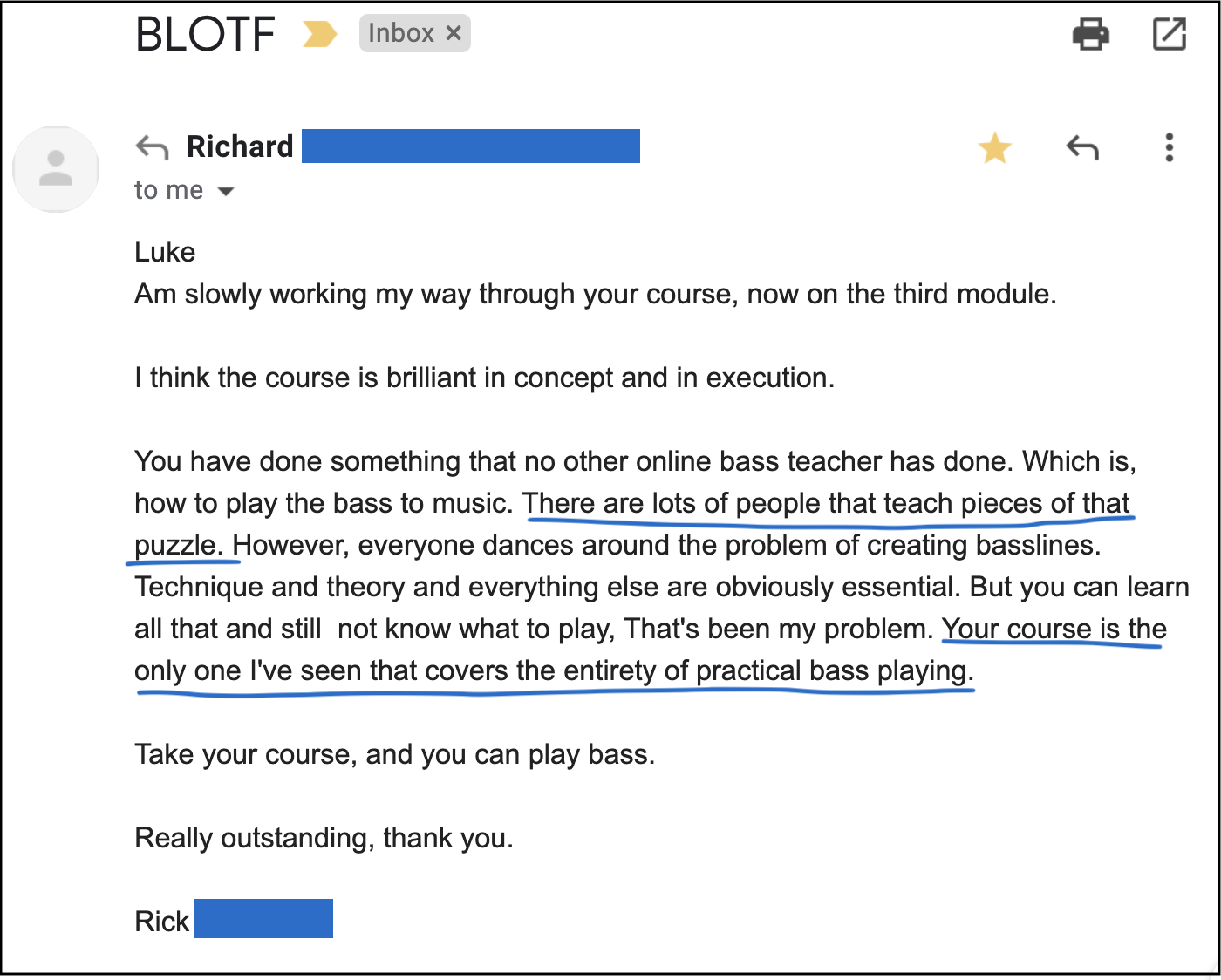

“I’ve had a handful of teachers, but nothing super serious like a summer here and there during college. I feel I got more out of these 6 weeks than I did from any of those lessons.”
Alex D.

The trio I’m playing in got a short notice offer on a chance to play last night…When we were packing up, a number of people I’ve never met came up and told me – the bass player!?- how much they enjoyed our sound, (In my experience, friends do that, but not usually strangers). The owner came up and told us he rarely had as enthusiastic an audience…I had a wonderful evening yesterday, and it seems that a whole lot of other people did too. You played a huge part in that! Thank you very much.”
Joshua C.

“[The course] has exceeded my expectations…The biggest win for me is that I feel myself moving towards an ability to create bass lines and to improvise through a structured process. I once thought that ability was a talent some musicians were born with but I now see that it is a skill that can be learned.”
Dave M.

“Before, I felt like, I didn’t even know where to start, other than playing roots and 5ths, whereas now I have a much better palette of sounds I can choose from…Not only does this make me more confident to join in a jam or with a different band, it makes me more confident to play music I’m not necessarily familiar with.”
Chris P.

“I’m having more fun just jamming and making stuff up. Now I don’t even care how that other bass player did it, because guess what – I’m going to make it my own. It gives you the confidence you can just do it.”
Denise C.

“Definitely, I was a novice before this course…Now I feel like the ‘novice’ is in the rear view mirror. It gave me a lot more confidence which affects your playing too…To actually do a bass line on the fly that makes sense and sounds good, it’s kind of like, “Oh my gosh, I’m doing it!”. You’re doing it and you’re not even thinking about what your fingers are doing. Your mind is transported and it’s connecting with your fingers and it’s happening for you. That was very exciting!”
Herm S.

“One day [my teachers and I] were jamming and I just started thinking, “Oh OK – I could use this” and go up and then come back to the next chord or I could do this and do that. And my teachers were blown away and they were very happy.”
Patty H.


“Before the course, I was a ‘memorise the tabs’ kind of person…Now I have a much greater appreciation of what’s available to me that would sound good.“
Jamie S.

“When I was a kid in high school, 12/13 years old, there were a bunch of guys and they would just jam. I was so envious that they could ‘just’ jam and improvise – it’s something I’ve wanted to do since then. Finally – I’m getting close, so it’s really rewarding.”
Rob G.


“[The bass line ‘spices] make it a lot easier for me to know that right off the bat there are…a lot of options I didn’t have in my play book before, which I can use during whatever jam or song I’m doing.”
Mike E.



